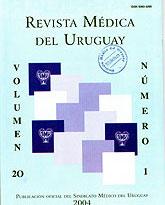Experiencia metodológica en pesquisa neonatal de hiperfenilalaninemias
Instituto de Genética Médica (Hospital Italiano)
Resumen
La detección neonatal de errores congénitos del metabolismo mediante pesquisa neonatal consiste en la búsqueda sistemática en el recién nacido de aquellas afecciones para las que existe un tratamiento probadamente efectivo ante su instalación precoz. En el Instituto de Genética Médica del Hospital Italiano se realiza, desde noviembre de 1993, la cuantificación de fenilalanina sanguínea en el recién nacido en sangre seca sobre papel de filtro mediante método fluorométrico como test de pesquisa para hiperfenilalaninemias. Los reactivos son preparados en el laboratorio y la exactitud del método es controlada a través de un programa de control de calidad externo por método de referencia. En el presente trabajo se estimó el valor de punto de corte en función del cual considerar un resultado como presuntamente positivo para nuestra población (n=190), obteniéndose un valor de 2,5 mg/dl de fenilalanina. Se evaluó el método fluorométrico utilizado. El análisis de regresión entre los resultados obtenidos por el método en uso y el de referencia mostró que existe asociación lineal entre estos resultados (n=93; r=0,94; y= 0,87x + 0,519) y que aunque ambos métodos no son intercambiables, sí son equivalentes, lo cual otorga confianza al método en uso. Se examinó la estabilidad de la Phe en muestras de sangre recogidas sobre papel de filtro almacenadas a 4ºC. El porcentaje del aminoácido recuperado después de cinco años de almacenamiento (83% a 100%) y el test estadístico aplicado mostraron que el aminoácido tiene buena estabilidad almacenando las muestras en esas condiciones.
Citas
2) Committee on Genetics. Aspectos del screening neonatal. Pediatrics (ed. esp.) 1992; 33:103-7.
3) Bickel H. Rationale of Neonatal Screening for Inborn Errors of Metabolism. In: Bickel H, Guthrie R, Hammersen G, eds. Neonatal Screening for Inborn Errors of Metabolism. Berlín: Springer, 1980:1-6.
4) Wilcox WR, Cederbaum SD. Aminoacid metabolism. In: Rimoin DL, Connor JM, Pyeritz RE, Korf BR, eds. Emery and Rimoin's: Principles and Practice of Medical Genetics. 4ª ed. London: Churchill Livingstone, 2002:2405-40.
5) Smith I, Lee P. The hyperphenylalaninemias. In: Fernandes J, Saudubray JM, van der Berghe GV, eds. Inborn Metabolic Diseases. Diagnosis and treatment. 3ª ed. Berlín: Springer-Verlag, 2000:170-83.
6) Corsello G, Bosco P, Calí F, Greco D, Cammarata M, Caccio M, et al. Maternal phenylketonuria in two Sicilian families identified by maternal blood phenylalanine level screening and identification of a new phenylalanine hydroxylase gene mutation (P470L) Eur J Pediatr 1999; 158(1):83-4.
7) Enns GM, Martinez DR, Kuzmin AI, Koch R, Wakeem CK, Woo SL, et al. Molecular correlations in phenylketonuria: mutation patterns and corresponding biochemical and clinical phenotypes in a heterogeneous California population. Pediatr Res 1999; 46(5):594-602.
8) Guttler F, Azen C, Guldberg P, Romstad A, Hanley W, Levy HL. Relationship among genotype, biochemical phenotype, and cognitive performance in females with phenylalanine hidroxylase deficiency: report from the maternal phenylketonuria collaborative study. Pediatrics 1999; 104(2 Pt 1):258-62.
9) Smith I. Treatment of phenylalanine hydroxylase deficiency. Acta Paediatr Suppl 1994; 407:60-5.
10) Schmidt H, Burgard P, Pietz J, Rupp A. Intelligence and professional career in young adults treated early for phenylketonuria. Eur J Pediatr 1996; 155(Suppl 1):S97-100.
11) Cockburn F, Clark BJ. Recommendations for protein and amino acid intake in phenylketonuric patients. Eur J Pediatr 1996; 155(Suppl 1):S125-9.
12) Azen C, Koch R, Friedman E, Wenz E, Fishler K. Summary or findings from the United States Collaborative Study of children treated for phenylketonuria. Eur J Pediatr 1996; 155(Suppl 1):S29-32.
13) Rafaelli A, Dell' Acqua A. Pesquisaje neonatal (PN) de hiperfenilalaninemias (HFA): 1er. caso detectado en el Uruguay. Congreso Uruguayo de Bioquímica Clínica, 1º. Montevideo. Uruguay, 1997:71-2.
14) Gutrhie R, Susi A. A simple phenylalanine method for detecting phenylketonuria in large population of newborn infants. Pediatrics 1963; 32:338-43.
15) McCaman MW, Robins E. Fluorometric method for the determination of Phenylalanine in serum. J Lab Clin Med 1962; 59:885-90.
16) Wendel U, Koppelkaumm M, Hummel W, Sander J, Langenbeck U. A new approach to the newborn screening for hyperphenylalaninemia use of L- pheylalnine dehydrogenase and microtiter plates. Clin Chim Acta 1990; 192(3):165-70.
17) Chace DH, Millington DS, Terada N, Kahler SG, Roe CR, Hofman LF. Rapid diagnosis of phenylketonuria by quantitative analysis for phenylalanine and tyrosine in neonatal blood spots by Tandem Mass Spectrometry. Clin Chem 1993; 39(1):66-71.
18) Chamoles NA, Spécola N. Encefalopatías evolutivas: errores congénitos del metabolismo. In: Fejermann N y Fernández Álvarez E, eds. Neruología Pediátrica. 2 ed. Buenos Aires: Panamericana, 1997:319-82.
19) Mathias D, Böttcher M, Gebhard J. Quality Control in Neonatal Screening for Inborn Errors of Metabolism. Short communication. Clin Lab 1998; 44:51-60.
20) Philips RE, de Boton R. (A Clinical Laboratory Procedure from G.K. Turner Associates, Inc., 2524 Pulgas Avenue, Palo Alto, California 94303): A simplified determination of blood phenylalanine using samples collected on paper.
21) Holtzman NA, Mc Cabe ERG, Cunningham GC, Berry HK. Screening for phenylketonuria. N Engl J Med 1981; 304(21):1300-1.
22) Siest G. Simposio Valores de Referencia. Congreso de Bioquímica Clínica, 2º; Montevideo, Uruguay; 1999:23-5.
23) Weiner DL, Canton RM, Mitchel PL, Mannes P. False positive rate in neonatal phenylketonuria (PKU) screening using a 2 mg/dl phenylalanine (PA) cut-off. Am J Hum Genet 1981; 33:94A.
24) Erbe RW, Levy HL. Screening neonatal. In: Rimoin DL, Connor JM, Pyeritz RE, eds. Emery and Rimoin's: Principles and Practice of Medical Genetic. 3 ed. New York: Churchill Livingstone, 1997:581-93.
25) Doherty LB, Rohr FJ, Levy HL. Detection of phenylketonuria in the very early newborn blood specimen. Pediatrics 1991; 87(2):240-4.
26) Jew K, Kan K, Koch R, Cunningham GC. Validity of screening early collected newborn specimens for phenylketonuria using a fluorometric method. Screening 1994; 3:1-9.
27) Smith I, Cook B, Beasley M. Review of neonatal screening programme for phenylketonuria. BMJ 1991; 303(6798):333-5.
28) Levy HL, Simmons JR, MacCready RA. Stability of amino acids and galactose in the newborn screening filter paper blood specimen. J Pediatr 1985; 107(5):757-9.














